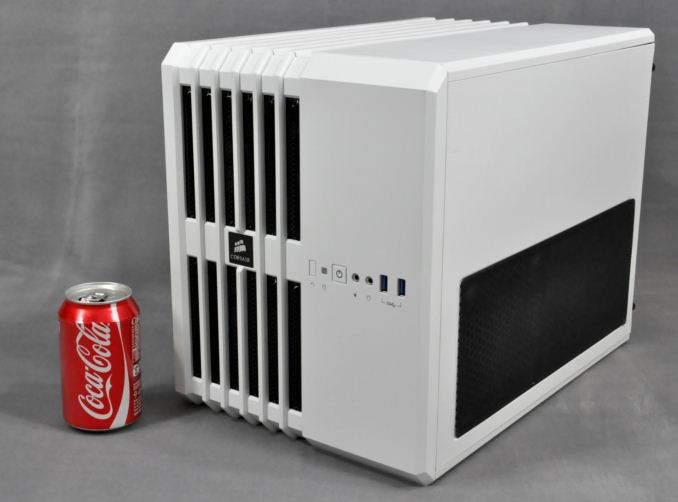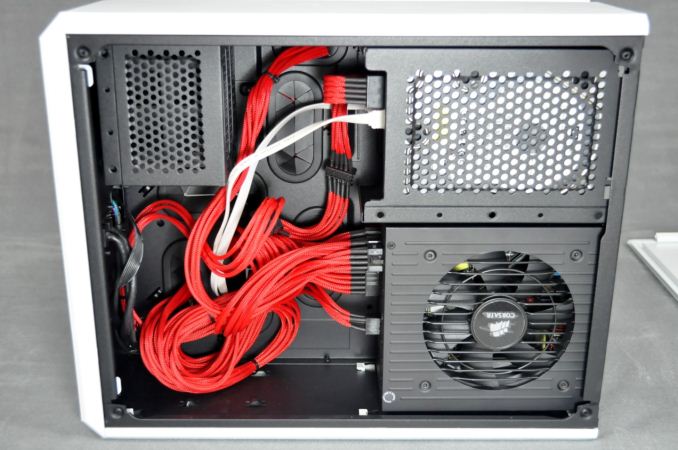Corsair Carbide Air 240 Case Review
by E. Fylladitakis on August 15, 2014 6:00 AM EST- Posted in
- Cases/Cooling/PSUs
- Corsair
- ATX
- Case
- Carbide
Conclusion
Aesthetically, the Carbide Air 240 is certainly eye-catching and very well designed. We cannot really claim that it is a unique case, both because many cubic cases are available and because it is based on the same external design as the Carbide Air 540, a case released over a year ago. However, this does not reduce the aesthetic value of the Carbide Air 240. Based on a minimalistic design of simple geometric shapes and grids, the Carbide Air 240 is a case that attracts attention without being extravagant. It is an understated, yet elegant design that ought to look great on any desk.
Due to its unorthodox shape, there are some limitations as well. For example, despite the width of the case, it is not possible to install very tall CPU coolers, leaving the end user to either settle for a smaller cooler or go for a liquid cooling solution instead. The large width is also going to be a problem for spaces and offices designed to hold standard tower cases, as the cubic Carbide Air 240 will obviously not fit.
One major weakness of the Carbide Air 240 is that there are no external drive slots, for 3.5" or 5.25" devices. Some advanced users have ditched optical media (never mind floppy disks and the like) a long time ago, but others still like to install a DVD-RW or Blu-ray drive. This severely limits the potential of the Carbide Air 240 to be used as a media center. However, that was never the intended purpose of this case, as it has obviously been designed to house little monster gaming PCs, not to function as an HTPC.
When it comes to performance, the Carbide Air 240 delivers as promised. It should easily be able to cover the thermal needs of even the most powerful gaming system that can fit inside it, even with the stock cooling setup if no overclocking takes place. For low-noise setups and overclocking, the installation of at least a good CPU cooler is highly recommended. If a Mini-ITX motherboard is installed, the installation of two liquid coolers, one for the CPU and one for the GPU respectively, can help to create a very powerful system with low operating noise. Unfortunately, due to space limitations, the installation of two GPUs and two liquid coolers does not seem possible, so it would be rather difficult to create a silent dual-GPU gaming system.
As far as quality goes, the Corsair Carbide Air 240 is a very well made product for its class. The plastics are solid and the mechanical cohesion of the chassis is very good as well. Our only complaint would concern the use of metallic meshes as dust filters. Although these metallic meshes are durable and convenient, they will not help with smaller dust particles at all. Furthermore, the panels need to come off in order to clean them, which is not very convenient. The mesh on the right side panel is an exception, as it is denser and can be cleaned very easily.
Recommending the Carbide Air 240 is easy enough, though as usual that depends on individual preferences. Aside from the fact that aesthetics are an entirely subjective matter, which is typically a major factor when it comes to choosing a case, the unorthodox design of the Carbide Air 240 is simply not meant for the majority of the users. Simply put, it is not a product meant for the average Joe to stick beneath an office desk and forget about it. Instead, this is a case meant to show off your powerful and yet compact gaming system, with an eye-catching cubic design. If that's what you're looking for, the Carbide Air 240 is definitely worthy of consideration. Pricing is reasonable as well, with both the white and the black models listed at Amazon and priced at $90 – $40 less than the larger Carbide Air 540.












63 Comments
View All Comments
darkbreeze - Friday, November 14, 2014 - link
The biggest problem with this case has nothing to do with the drive or lack therof. Seems no decent GPU cards will fit due to card HEIGHT not length. Even the ones made for mini-ITX enclosures don't fit as seen here:http://www.tomshardware.co.uk/answers/id-2363784/a...
Zak - Wednesday, April 15, 2015 - link
I want this case for a gaming-only build that will only have couple of SSDs in it so I'm happy with the absence of 5.25" bays. I had 540 and it was too large with tons of wasted space and was taking up too much floor space so I went back to a regular tower for that build.RealAntithesis - Tuesday, March 13, 2018 - link
A few years after the date of this article, but hey: I built a Ryzen system using this case. Main reason I chose the case was its looks and small footprint. However, some issues I've come across that people should consider when buying:1. As mentioned in the article, there is no room for a second dual slot video card at the bottom of the case - some matx motherboards have a 16x slot at the bottom, but the Air 240 can't accommodate one without some case modification work due to lack of a fifth expansion bay. A 2nd video card could fit in the in the third expansion slot though (assuming the motherboard has a 16x pcie slot here).
2. Also as mentioned in the article, air coolers are limited due to the height restrictions. However, the noctua c14s does fit, but only in its single fan configuration placing the fan close to the motherboard. I also rotated the heat sink 180 degrees to avoid getting too close to the ram sticks. The c14s takes up a large chunk of the horizontal area of the side panel window, but gives decent cooling performance (and it fits, albeit fairly tightly with surrounding components).
3. The side window is made of plastic. Due to the lack of clearance, the 6 and 8 pin power cables from my 1080ti have squeezed up against the window. Unfortunately, with the video card routinely getting to 80C (it's hot over here, and that's running at 60% power limit), the plastic window now has little grooves where the wires from the power cable were touching, presumably from the heat. Obviously, I need to work on temps, but the side window should be made out of tempered glass like some others are.
4. The case panels are made out of plastic, including the bars covering the fan vents on the top. While this probably reduces weight, this unfortunately means it's not very strong. It's quite easy to press slightly on the panel, causing it to bend and causing the spinning fan on the other side to hit something, maybe the grill (I'm not sure, but I wasn't about to do that again if I could help it).
5. The metal grill and / or the plastic between the top fan and plastic panel tends to vibrate with the fan, resulting in a very audible and annoying hum or buzzing noise. Then I have to press in various places to touch the sweet spot to quieten it down again. It's quite annoying.
6. That's it. Apart from all the above, it's otherwise a decent case, but I'm thinking of switching it out for another.